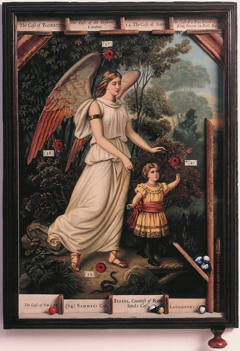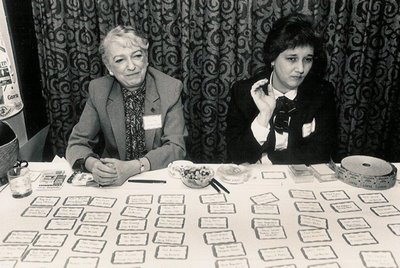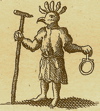 Johann Dieter Wassmann, Guardian Angel, 1888. 660 x 450 x 60mm. Day seven in the Twelve Days of Christmas.
Johann Dieter Wassmann, Guardian Angel, 1888. 660 x 450 x 60mm. Day seven in the Twelve Days of Christmas.
Sunday, December 31, 2006
Seven shiny marbles
 Johann Dieter Wassmann, Guardian Angel, 1888. 660 x 450 x 60mm. Day seven in the Twelve Days of Christmas.
Johann Dieter Wassmann, Guardian Angel, 1888. 660 x 450 x 60mm. Day seven in the Twelve Days of Christmas.
Saturday, December 30, 2006
Six moments passing
Friday, December 29, 2006
Five traits to ponder
Thursday, December 28, 2006
Four Medicean Stars
Wednesday, December 27, 2006
Three noble virtues
Tuesday, December 26, 2006
Two martrys in an elm tree
Monday, December 25, 2006
The Twelve Days of Christmas... a child is born
 Johann Dieter Wassmann, L'Enfant Moses, 1893. 335 x 250 x 155mm.
Johann Dieter Wassmann, L'Enfant Moses, 1893. 335 x 250 x 155mm. Throughout Christendom, the Twelve Days of Christmas begins this evening. To celebrate, I will present a gift each day of the lesser-known works of Johann Dieter Wassmann. Here Johann depicts not the baby Jesus, but Moses on the River Nile. From inside a protective jar he peers out at a duck egg, from which the artist would appear to suggest the infant has recently emerged.
Sunday, December 24, 2006
Eppur Si Muove
 The Australian film-maker Richard Moore sent along word overnight that a trailer from his upcoming documentary The Foundation can now be seen on YouTube. While the clip focuses on Wassmann Foundation director Jeff Wassmann, Richard assures me the final cut of the film will examine more broadly the life and art of Johann Dieter Wassmann, along with the efforts of MuseumZeitraum to repatriate Johann’s works home to his native Leipzig.
The Australian film-maker Richard Moore sent along word overnight that a trailer from his upcoming documentary The Foundation can now be seen on YouTube. While the clip focuses on Wassmann Foundation director Jeff Wassmann, Richard assures me the final cut of the film will examine more broadly the life and art of Johann Dieter Wassmann, along with the efforts of MuseumZeitraum to repatriate Johann’s works home to his native Leipzig.
Thursday, December 21, 2006
Ruth Bernhard 1905 - 2006
 Ruth Bernhard, Chicago, Illinois, 1981. Photograph: Sophie Vogt.
Ruth Bernhard, Chicago, Illinois, 1981. Photograph: Sophie Vogt.Earlier today, I learned of the passing of Ruth Bernhard in San Francisco at the age of 101. When I first met Ruth in 1981, she was already 76 but I had little doubt she had 25 good years left in her. She has proven me correct. With an iron will and unswerving modernist convictions, Ruth was truly one of the greats of 20th century photography. She will be remembered as an inspired teacher and mentor to many, including myself.
Born in Berlin in 1905, Ruth studied at the Academy of Fine Arts before following her father to New York in the 1920s. A decade later, she headed west to Hollywood where she met Edward Weston, who would become her dear friend and soul-mate. Ruth soon reduced the nude to pure essence, creating several of the most iconic images of the female form of the modernist era, most notably In the Box, Horizontal 1962.
I first met Ruth in Chicago when she was touring with Margaretta K. Mitchell’s exhibition Ten Women of Photography. Accompanying her were two other greats of 20th century photography, Lotte Jacobi and Barbara Morgan. All are gone now, but the legacies of their kindness, vision and pioneering spirit will outlast us all.
Here’s a link to Ruth’s obituary in this morning’s Los Angeles Times.
Monday, December 18, 2006
Zaha Hadid's crystal ball
 Earlier this morning I had a breakfast meeting with executives at BMW's ultra-modern Zaha Hadid-designed Leipzig car plant as the Zeitraum Challenge spreads its wings in search of support to assure MuseumZeitraum reaches its full potential. While all talks remain confidential, I can say, what a remarkable place to go to work every day. Time to give up curating and start punching the clock. Here's a link with a look into the future of the workplace.
Earlier this morning I had a breakfast meeting with executives at BMW's ultra-modern Zaha Hadid-designed Leipzig car plant as the Zeitraum Challenge spreads its wings in search of support to assure MuseumZeitraum reaches its full potential. While all talks remain confidential, I can say, what a remarkable place to go to work every day. Time to give up curating and start punching the clock. Here's a link with a look into the future of the workplace.
Friday, December 15, 2006
L'Origine du monde
 Johann Dieter Wassmann, SCHLOSS, AUGUSTBURG, 1897. Albumen silver print, 18 x 23 cm, WF 725014.
Johann Dieter Wassmann, SCHLOSS, AUGUSTBURG, 1897. Albumen silver print, 18 x 23 cm, WF 725014.With the first forecast of snow in the coming days and Miami long forgotten, I thought I'd end the week with this rather suggestive, if brutalist, image -- bearing a clear reference to Courbet's L'ORIGINE DU MONDE, 1866 -- from the archives of The Wassmann Foundation, Washington, D.C.
Sunday, December 10, 2006
If art matters
 Johann Dieter Wassmann, ZEIT-RAUM, 1896. 470 x 270 x 160mm.
Johann Dieter Wassmann, ZEIT-RAUM, 1896. 470 x 270 x 160mm.I suspect few of the 40,000 heading home this weekend from Miami Basel chose the window seat for their return travel (excepting, of course, locals, those with private jets and those for whom the window seat was the last remaining in first class). It’s not a ‘window seat’ kind of crowd. Watching the lights of the Brittany coastline twinkle below on my way in to Frankfurt, I pine for the days when it was otherwise. I struggle to imagine Joseph Beuys strutting his stuff daily on South Beach, with his entourage in tow, or Marcel Duchamp screaming “I HAVE a reservation,” at Joe’s Stone Crab, both events I witnessed by artists who shall remain un-named. Art Basel Miami Beach is strictly Warhol territory, as is the art-world at large today.
Were Johann Dieter Wassmann to reincarnate himself in the present, I have little doubt he would be sitting in the window seat, as I am. Looking out through this tiny porthole into the night sky at 37,000 feet, I’m reminded of his work ZEIT-RAUM, the namesake for our museum dedicated to his life’s work. ‘Space-Time’, both as a work and as an institution, is a portal of sorts, a suspended moment that takes us from the mundane of everyday life into a slipstream of possibilities, where art is our chosen mode of transport and hope and dreams remain unbounded, not simply a tool for capital gain.
When I land in Frankfurt, I’ll have a three-hour delay before heading home to Leipzig, time enough to send this post and dash over to the Städelsches Kunstinstitut to spend another treasured moment with Vermeer’s GEOGRAPHER. Another time, another place, but a portal like no other. If art truly matters, this is still the reason why.
Friday, December 08, 2006
Welcome to the machine
 Given my life as a curator, rather than collector or critic, my intent in coming to Art Basel Miami Beach had been to engage in the discourse of the event, rather than wallow in celebrity, parties and gross revenues. How silly of me.
Given my life as a curator, rather than collector or critic, my intent in coming to Art Basel Miami Beach had been to engage in the discourse of the event, rather than wallow in celebrity, parties and gross revenues. How silly of me. There is no discourse in Miami. There is only money. While I’m not often prone to admit it, Robert Hughes was right about one thing. As he told The Guardian earlier this year, "The present commercialisation of the art world, at its top end, is a cultural obscenity.” Nothing could better describe these past few days, time spent in such vapid pursuits they're hardly worth reporting. The few programmed events that had promised more, such as the Conversation series, were either cancelled (Jacques Herzog was a no-show) or simply banal (a discussion this morning on what else – collecting).
So if you didn’t make it to Miami, don’t fret. My advice: from now till summer, put aside $10 a day (less if you live in Europe) and head to Kassel for Documenta 12, the last holdout on the art circuit where 'dis-course' doesn't refer to a pudgy-fingered New Yorker pointing to what he wants off the luncheon menu.
Thursday, December 07, 2006
Vernissage Art Basel Miami Beach
 Pictured: Artist Sally Smart at Jacob Karpio Galeria (Costa Rica)
Pictured: Artist Sally Smart at Jacob Karpio Galeria (Costa Rica)Art Basel Miami Beach is to art appreciation what Pamplona is to animal welfare. They also launch themselves in much the same manner. And the bulls are certainly running this evening here at ABMB’s Vernissage (brought to you in real time via BlackBerry). It would be doing no one justice to offer critique amidst such a well-groomed stampede, nor would it do me much good to continue nursing this metaphor. I will say, however, that the stand-out artist on first look is Sally Smart, an Australian showing at Jacob Karpio. Her ‘Exquisite Pirate’ installation, an expansive work exploring the discourse of women pirates (shown at ABMB on reduced scale) has been the talk of New York since Jerry Saltz’s rave about her in The Village Voice earlier in the year when the work was shown at Postmasters. The installation is currently on view at Jacob’s San Jóse gallery; an all-new work on the theme is set to open at Hunter College’s mid-town gallery next month. We would hope to see her across the pond sometime soon. First we take Manhattan, then we take Berlin?
You won’t find Smart listed on ABMB’s web catalogue, as we suspect she was a late ring-in, but here’s a link to her own website:
Wednesday, December 06, 2006
Hot, hot, hot
 Art Basel Miami Beach doesn’t officially open until Thursday, but the art of commerce has been well under way for several days. Earlier this evening, I stopped by the UBS party on South Beach, where Tyler Green enthusiastically explained to me, “Miami is the new Davos.” Less the protesters, Tyler.
Art Basel Miami Beach doesn’t officially open until Thursday, but the art of commerce has been well under way for several days. Earlier this evening, I stopped by the UBS party on South Beach, where Tyler Green enthusiastically explained to me, “Miami is the new Davos.” Less the protesters, Tyler. Landing in Miami mid-day, the tarmac was already crammed with private jets hunkered down for the week. Curbside, BMW’s fleet of 25 chauffeured 7-series motor cars was busy ushering VIP guests to and fro -- indeed, die dynamischste Limousine der Oberklasse. I might have caught a glimpse of Dennis Hopper gliding away in one, but I can't be certain.
What a difference a year and a mid-term election make. 12 months ago, we ‘old’ Europeans were on the receiving end of profuse apologies for the actions of The Great War-Monger, as Borat hails him. Today, it’s victory to the left and the war seems largely forgotten. Too bad no one told those poor sods still in the trenches, the ones who forgot to go to Yale, that the war is resolved. Might I remind you, it isn't.
Oh yes, if you were hoping to learn something about art in Miami, I haven’t spotted any yet, just commerce. Tomorrow's another day.
Sunday, December 03, 2006
Miami FLA...

Like the lemming that I am, it’s Frankfurt-to-Miami via Dulles later today for the madness of Art Basel Miami Beach. Monday and Tuesday, I’ll be stopping through Washington, D.C., as negotiations continue with The Wassmann Foundation to repatriate the works of Johann Dieter Wassmann home to his native Leipzig. Technology, immigration and sobriety permitting, I’ll do my best to keep you posted through the week.
Friday, December 01, 2006
Freundschaftstempel
Subscribe to:
Comments (Atom)






